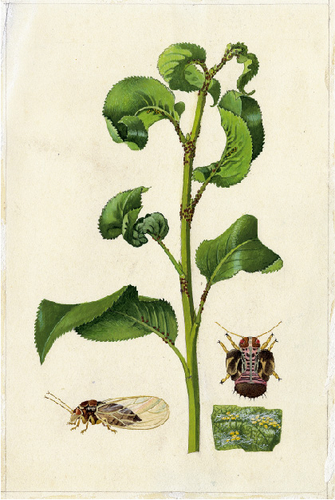Pear psylla
Cacopsylla sp.
Appearance
Pearleaf suckers, which are plant suckers, are classified in the leaf sucker or leaf flea family (Psyllidae).
There are three species of pearleaf suckers:
- Greater pearleaf sucker(Cacopsylla pyrisuga).
- Common pearleaf sucker(Cacopsylla pyri)
- Spotted (Small) pearleaf sucker (Cacopsylla pyricola)
The Large Pearleaf Sucker is 3 to 4 mm long, initially light green and later dark brown in color. The other two pearleaf sucker species are much smaller (about 2 -3 mm) and dark colored.
The larvae, which are about 1.5 to 2 mm in size, are flattened, yellowish red to brown in color, and develop into adult leaf fleas over several larval stages.

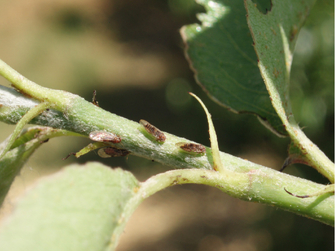
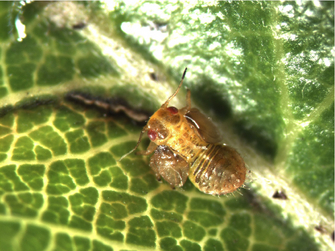
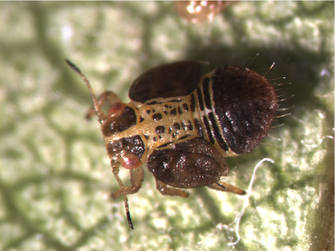
Biology
Pearleaf suckers appear from spring onwards and, depending on the species, can be found until summer, with a preference for still young shoots.
The large pear leaf sucker occurs with only one generation per year and makes a host change. The adults prefer to overwinter on coniferous trees. In spring they return to their host plants (pear trees). At the time of bud break, eggs are laid singly or in clusters on young leaves, petioles, and on shoots. Egg-laying occurs in two large spurts with an interval of four to six weeks (about late March and late May). From the middle of May the larvae appear. They sit densely packed on leaf undersides, petioles, and shoots, suck their food from the plant, and secrete large amounts of liquid feces ("honeydew") so that soon entire shoots and leaves are covered with it. The larvae like to attach themselves to the base of the still soft shoots. From June, the adults appear, usually sitting on the undersides of leaves with their wings folded like a roof. Adult leaf fleas can jump well, they leave the bulb after sucking on the leaves for a short time and migrate in June. They return to pear trees the following spring before buds swell.
Unlike the large pearleaf sucker, the common pearleaf sucker does not have a host rotation and hibernates in bark hiding places of host trees or in the litter layer on the ground. They begin laying eggs on twigs and buds very early (about March). Depending on the weather, several (three to five) generations are formed per year. Individuals of this species are therefore also present in summer.
The spotted pearleaf sucker has a similar biology and way of life as the common pearleaf sucker (several generations per year, no host change).

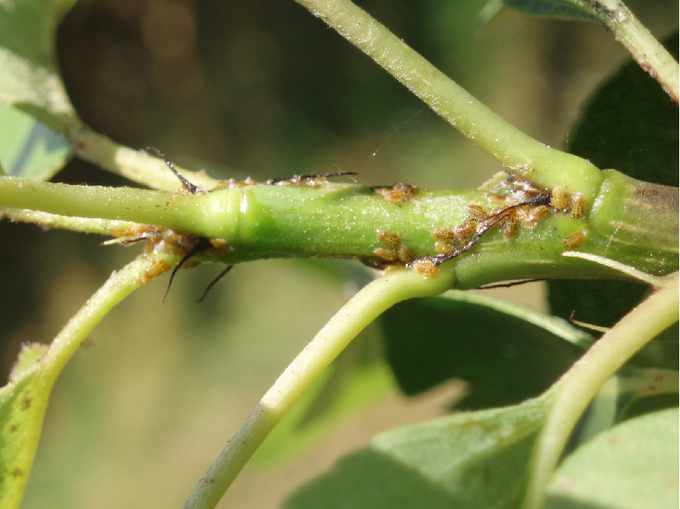
Damage symptoms
In late spring, the small larvae, which often sit in large numbers on the shoots, and the sometimes severe curling and rippling of the leaves and shoots caused by their sucking activity are clearly visible. As a result, the shoots turn black and die. Abundant excretion of sticky honeydew allows sooty mold to colonize, producing blackish coatings on fruit and shoots.
Good indicators of leaf sucker occurrence are the migrating ants that ingest the honeydew.
The common pear leaf sucker causes similar damage to the great pear leaf sucker. However, leaf curling and deformation are less despite very heavy droppings.

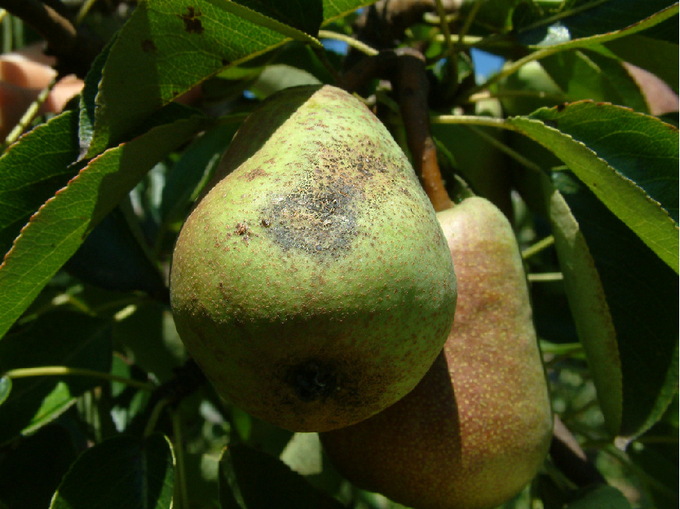
Economic significance
Severe infestation can significantly reduce fruit set and cause severe shoot compression, which can lead to death. In addition, honeydew and sooty mould fungi cause contamination of the fruit and thus a reduction in quality.
All three leaf flea species are of great importance as vectors of pear decline. Pear blight is a disease caused by phytoplasmas ('Candidatus Phytoplasma pyri'). It is already widespread in Austrian pear-growing regions.
Prevention and control
Direct measures:
- Cut off and destroy severely damaged shoots.
- Sprout treatments (seelist of plant protection products approved in Austria) can kill some of those overwintering on trunk and branches.
- Spring treatment: when larvae appear, with insecticides approved for this purpose (seelist of plant protection products approved in Austria). Heavily infested shoots that are still soft can be dipped into the spray broth. Since honeydew protects them, it is favorable to carry out treatments with high pressure and increased application rates or after heavy rainfall (honeydew is partially washed off by the rain). Early treatments prevent damage in summer.
- Insecticides with development-inhibiting activity approved for the treatment of leaf suckers (see list of plant protection products approved in Austria) should be applied from the beginning of egg laying in spring, larvicidal preparations from the hatching of the larvae.
Biological control:
The most important natural enemies of pearleaf suckers are the predatory flower bugs (Anthocoridae), but also ladybugs, lacewings and earwigs.
Specialist information
Publications
Lethmayer, C., Hausdorf, H., Suarez-Mahecha, B., Reisenzein, H., 2011. The importance of psyllids (Hemiptera: Psyllidae) as vectors of phytoplasmas in pome and stone fruit trees in Austria. Bulletin of Insectology, 64, 255-256.
Reisenzein, H., Lethmayer, C., 2016. Studies on the interaction between 'Ca. phytoplasma pyri' and the vectoring psyllids. IOBC-WPRS Bulletin, 112, 55-60.
Our monitoring activities
In 2009, 2010 and 2011 Psyllidae collections were made in pear orchards in Lower Austria.
Projects
EU-ERANET EUPHRESCO-II-Project APOPHYT: "Evaluation of factors determining distribution, impact, detection and characterisation of fruit tree phytoplasmoses", 01.09.2012 - 31.08.2014, project partner
BIOLURE project: "Control of insects with olfactory attractants and repellents. Development of innovative attractant traps for the monitoring and mass trapping of phytoplasmosis vectors on pome fruit", 01.01.2012 - 31.08.2014; project partner
UTA-PD-NÖ-Project: "Investigations of the table pear Uta for commercial fruit cultivation for susceptibility to the pathogen of pear decline and the role of leaf suckers (Psyllidae) as vectors", 01.01.2012 - 31.12.2013; Project partner
Last updated: 21.10.2024
automatically translated
